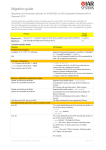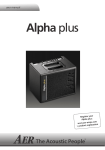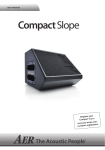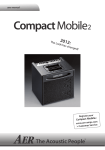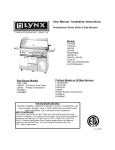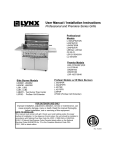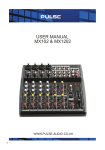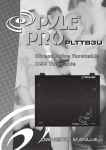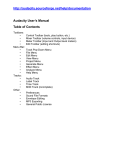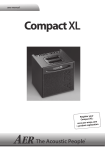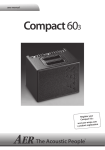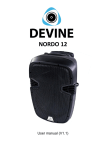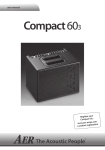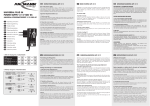Download S- 75 • S-100 • S-150
Transcript
S- 75 • S-100 • S-150 Contents Device features......................................................................................2 1. Introduction . ......................................................................................3 2. Notes on safety..................................................................................4 3. Becoming acquainted with the operational components ...................5 4. Connection and operation .................................................................7 5. Operational safety precautions . ........................................................8 6. Connecting the amplifier . ..................................................................8 7. Switching between modes . ...............................................................9 8. Selecting input sensitivity ................................................................10 9. Switching on ....................................................................................10 10. Additional operational information .................................................10 11. Disposal.......................................................................................... 11 12. Technical Data................................................................................12 Device features XX Fanless cooling, ideally suited for studios XX Space saving design with only one rack space XX Works with a 2 Ω load XX Efficient protective circuitry XX Balanced XLR and jackplug inputs XX Toggle switch for input sensitivity XX Parallel and bridged operations are possible XX Speaker outputs for Speakon and terminals Page 2 User Manual These instructions do not provide all information regarding the device's design, production or possible modifications. It also does not cover every possible situation that can occur during installation, operation or maintenance. If you should require special assistance that is not covered by the information given here please contact our technical support department. PAY PARTICULAR ATTENTION TO THESE SYMBOLS: This sybol, wherever it appears, warns of uninsulated power sources DANGEROUS VOLTAGE inside the device so that a LIFE THREATENING situation from electrical shock exists! This symbol, wherever it appears, reminds you of SAFETY RELEVENT paragraphs of these instructions and/or accompanying documents. Therefore READ THESE INSTRUCTIONS! 1. Introduction Congratulations on the purchase of your power amplifier. Your choice shows that you enjoy excellent sound reproduction. We are pleased by your purchase and are proud of the long tradition of quality, high-class devices for which our company stands. In order to get the best out of your amplifier you should read the entire instructions before you connect and put it into operation. The instructions will acquaint you with all the necessary information for connection and operation so that your audience will listen with great pleasure from the start. Thereby you will ascertain our efforts, during the design and production stages of the device, to fulfill your wishes and expectations regarding ease of use and adaptability. Please keep these instructions for future reference. Make a note of the device's serial number, located on the rear panel, here in the instructions. Should you contact your dealer regarding further information or service for this device you will be able to supply him/her with the model and serial numbers even when the device is mounted in the rack. MODEL__________________ Serial number__________________ FOR YOUR SAFETY YOU MUST READ THE CHAPTER "SAFETY INFORMATION" IN ANY CASE. Page 3 2. Notes on safety For your own safety you should read through this chapter at first completely! Risk of electrical shocks. • Only connect the device to a properly wired and earthed mains power socket with mains voltage of 230 V ~ /50 Hz. • Do not operate the device if the power cord or the mains plug are damaged. • Never submerse the device in water. Wipe it with a slightly moistened cloth only. • Do not expose the device to rain and never use it in a damp or wet environment. • Make sure that the power cord never becomes wet or moist during use. • Under no circumstances may you open the device housing. Should you do so your safety would not be assured and the warranty will become void. There are no operational components whatsoever inside, only really high voltage that can give you a deadly shock! • Do not place objects containing fluids, e.g. flower vases or beer bottles, on or near the device. • Always operate the device only on a correctly earthed socket, never sever the power cord's earth wire. Otherwise a LIFE THREATENING situation exists! • Notice regarding disconnection from mains-power: To completely disconnect the device from mains power, you must pull the plug from the power socket. For this reason the device should be placed in a position where unobstructed access to the power socket is assured at all times, so that in an emergency you will be able to immediately pull out the plug. To eliminate the risk of fire you should completely disconnect the power plug from the power socket when the device is not going to be used for a long time, for example, during holidays. • Always grasp the power cord by the plug. Do not pull on the cord itself and never touch the power cord with wet hands as this could result in a short circuit or an electrical shock. Do not place the device, speakers or anything else on the power cord and make sure that it does not become clamped. Never tie knots in the power cord and do not bind it together with other cables. Lay the power cord so that no one can step on or stumble over it. A damaged power cord can cause a fire or an electrical shock. Check the power cord from time to time. Should it become damaged contact our customer service department to have it replaced. • • • • • • Risk of fire! Never leave the device unattended during operation. Never cover the ventilation slots of the device while it is on. Do not place the device in locations that are subject to direct sunlight. If you do, it may overheat and become irreparably damaged. Do not operate the amplifier on surfaces that restrict normal airflow around the device, for example, a bed, sofa, carpet or similar surfaces. Do not place open fire sources, such as candles, on the device. Never operate the amplifier in the vicinity of heat sources such as cookers, heating elements or other heat producing installations. Before a storm and/or a thunderstorm with a risk of lightning, please disconnect the device from the electrical power source. Risk of personal injury! • Keep children away from the power cord and the device. Children frequently underestimate the dangers of electrical devices. • Provide a stable location for the device. • Do not operate the device if it has sustained a fall or is damaged. Have the device checked or, if necessary, repaired by qualified technicians. Page 4 3. Becoming acquainted with the operational components 3.1 . . . front q CLIP w CH-1 e CLIP Indicator for maximum level in channel 1 This indicator lights up when the output power of channel 1 has reached its maximum value. If the indicator lights up continually the power in this channel must be reduced. For this turn the input level controller for channel 1 w counter clockwise. Input level controller for channel 1 With this controller you decrease the input level in channel 1 to the respective dB value indicated on the scale. At the right end stop the attenuation is "0" and the full signal is amplified with maximum power. Indicator for maximum level in channel 2 This indicator lights up when the output power of channel 2 has reached its maximum value. If the indicator lights up continually the power of this channel must be reduced. For this turn the input level controller for channel 2 r counter clockwise. Page 5 r CH-2 t PRO y BR u PAR i ON o POWER Input level controller for channel 2 With this controller you decrease the input level in channel 2 to the respective dB value indicated on the scale. At the right end stop the attenuation is "0" and the full signal is amplified with maximum power. Indicator for activated circuit protection This indicator lights up when, in either of the two channels, one of the following situations occurs: • 3-5 seconds after switch on since now the speakers are still electrically disconnected from the power amplifier. • The temperature of the power amplifier transistors exceeds 85°C. • There is a malfunction in the device. Indicator for bridged mono operation In this case amplify both channels together with the signal at input 1. This leads to a significantly higher single channel output power. Then do not connect any signals to channel 2. Indicator for parallel mono operation In this case amplify both channels with the signal at input 1. The amplified signal from input 1 is applied to both outputs (CH-1 & CH-2). Switch on indicator light Lights up while the device is in operation. ON / OFF switch Move this switch to the "I" position to switch the device on. During switch on the circuit protection is activated. After a few seconds you will hear 2 "clicks" now the speakers are electrically connected with the power amplifier and the device is ready. 3.2 . . . rear Page 6 Connection for the power cord/supply voltage (AC230V~/50Hz) with fuse holder Speakon speaker output channel 2, for the connection of SPEAKON cables (1+ 2+ 1— 2—) CH-1 Speakon speaker output channel 1, for the connection of SPEAKON cables (1+ 2+ 1— 2—) CH-2 Speaker terminals channel 2, for terminal connection of speaker wires CH-1 Speaker terminals channel 1, for terminal connection of speaker wires GROUND LIFT Toggle switch for earth potential (stereo, parallel, bridged) Operation mode toggle switch (stereo, parallel or bridged) CH-2 Jackplug input channel 2, symmetrical CH-2 XLR input channel 2 0,77V | 1,4V Switch for input adjustment CH-1 (MONO) XLR input channel 1 CH-1 (MONO) Jackplug input channel 1, balanced a s CH-2 d f g h j k l 1( 2) 2! 4. Connection and operation Unpacking Carefully open the package and check the contents for possible damage. Every one of our amplifiers is completely tested and thoroughly checked before leaving the factory and should therefore reach you in a faultless condition. If you should find any kind of damage promptly notify the shipping company that transported the device to you. Only the consignee can assert a claim against the shipping company for damages incurred during transportation. Therefore keep the package and all packaging materials for their inspection. You should keep the package and packaging materials even if no damage is present. Should you need, at some time, to ship the device, package it exclusively in the original packaging. Assembly The power amplifier has a housing that allows for installation in standard 19" racks provided this exhibits a sufficient depth. The device requires one height unit, on the front panel you will see 4 assembly openings for screwing to the rack rails. Important! XX Keep these instructions for future reference. XX Do not spill water or any other liquids over or in the device. Never operate the amplifier when it is standing in a wet environment. XX Make sure that the details for the supply voltage on the rear panel of the device correspond to the available supply voltage at the operation location. If in doubt ask an electrician. XX Never apply a higher voltage to the device's input than that required for full drive. XX Never direct the output signal of one power amplifier channel into the input of another power amplifier channel. XX You must never switch together the output of one amplifier parallel or in series with the output of another amplifier. XX Never connect the output of an amplifier with any kind of voltage source regardless of whether the amplifier is in operation or not. XX Never connect a red characterized connection with earth. Page 7 5. Operational safety precautions Firstly make sure that the details for the supply voltage on the rear panel of the device correspond to the available supply voltage at the operation location. If in doubt ask an electrician. Damages sustained through operation of the device with incorrect supply voltage are not covered by our warranty. Make sure that the power switch o is in the OFF position (O) before you carry out any plug connections on the device. It is also always worthwhile, when switching on, to return the input level controller w, r to the left end stop so that the speakers will not be damaged by, for example, an unintentionally high signal level at the input. Always only use the best electrical outlets, which are also equal to the power requirements, for power distribution to the devices. If the electrical outlets appear, for example, corroded or have rusted contacts or they are equipped with cables that are too thin this will affect the performance ability of the device. Use only good speaker wires to minimize performance loss in the cables. If you want to connect bare wires with the cable terminals it would be better if you first attached cable shoes to the cable ends. To supply the inputs of the device with a signal we recommend the use of quality high grade shielded cables which are provided with a properly soldered, good XLR plugs. 6. Connecting the amplifier Connecting the inputs The balanced inputs have an impedance of 20 kΩ and are compatible with the Line-Level-Signals of most devices. In the input you will find three pin XLR sockets as well as balanced jackplug sockets. The built in 1/4“ jackplug inputs can be used with balanced or unbalanced signal sources. This is the standard set-up with jackplugs: Stereo (unbalanced): Mono (unbalanced): Page 8 Mono (balanced): Connecting the speaker You can connect the speakers either with cable shoes or also with bare wires to the cable terminals on the rear panel of the device or you can use the Speakon sockets (1+ 2+ 1— 2—). The cable profile should be proportioned to the amplifier power and the cable length. Connect the red cable terminal (+, hot) with the positive connection of the speaker and the black terminal (—, earth) with the negative connection of the speaker. You must NEVER connect the "hot" +pin of an amplifier's output with the black —pin of the same amplifier (short circuit), or with the +pin of another amplifiers output. Switch the amplifier off before you carry out connections or disconnections. Mains voltage supply Before you connect the amplifier to the mains voltage supply you must make sure that the mains voltage switch, located on the underside of the device (resp. rearside for S-150), is in the position that corresponds to the actual mains voltage supply (in Germany 230V~). If in doubt ask an electrician. Power supply Only use the supplied mains cord to couple the connection for mains cord/Supply voltage a with a properly connected and earthed (!) IEC household mains socket. 7. Switching between modes With this mode toggle switch j located on the rear panel you determine the operating mode for the power amplifier, stereo, parallel or mono bridged. Never activate this switch when the device is turned on. Stereo operation For two channel operation (stereo) slide the mode toggle switch j to the STEREO position. In stereo operation both channels work independent from each other and the position of the corresponding input level controller determines the respective power level. The signal at the respective input (CH-1|CH-2) is amplified and is applied to the corresponding output. Page 9 Parallel operation The parallel mode works mono. It serves thereto, to be able to connect lower impedances (down to 2 Ω) as in normal operation without thereby overloading the power amplifier. For this you move the mode toggle switch j to the "PARALLEL" position. In parallel operation you may only connect the signal to the input CH-1. The device amplifies the input signal in both channels and puts it out jointly via the outputs "CH-1" and "CH-2". Then you connect the two positive "+" speaker connections together and the two negative "—" speaker connections together. Then you can connect, to the device, one or more speakers. Bridged mono operation You can interconnect both power amplifier channels (bridge) and in this way you get a really powerful single channel Power-Amp. For this you move the mode toggle switch j to the "BRIDGED" position. In bridged mono operation both channels work together thus achieving effectively double the performance of a single channel. Always be especially careful when operating bridged power amplifiers because then a higher voltage is applied to the output. Also always take into consideration that the speakers must then have a considerably higher power rating! You connect the signal to be amplified to the input CH-1. You connect one or more speakers to the two red speaker terminals. The red speaker connection of the channel CH-2 is thus "in Phase" with the input. That means: Speaker "+" => "+" Pole channel CH-2 Speaker "—" => "+" Pole channel CH-1 When in operation you control the volume only with the input level controller CH-1 w, the input level controller CH-2 r then has no function. The input signal from channel CH-2 is disconnected in this operational mode. You must never earth either of the two speaker wire cores with bridged operation since both cores are "hot". If you use a Patchbay on the output side, all connections must be insulated from each other and from earth/ ground. 8. Selecting input sensitivity Here you set the input level by which the power amplifier should deliver its power rating "0,77V" for devices with -10 dBV outputs or "1,4V" for connection of devices with +4 dBV outputs. Often several amplifiers are operated simultaneously. If you set this switch to „26db“, all connected amplifiers will amplifiy the input signal with the same power. So you can combine different amplifiers of the S-series and get always the same output volume. 9. Switching on Press the POWER switch o on the front panel to the "I" position to switch the device on. To switch the device off again move the switch to the "O" position. 10. Additional operational information Power controller The input level controllers CH-1 w and CH-2 r on the front panel determine the signal amplification in the respective channel. If possible turn this controller all the way to the right end stop (= 0 dB attenuation) in order to enable the system to achieve its optimal headroom. Professional power amplifiers then deliver their power rating so long as an input voltage of 0,775 V and/or 1,4 V (depending on the switch setting for the input sensitivity) is applied. Page 10 Signal Ground Lift Switch In a system that, with reference to safety and low auxiliary noise, is optimally configured the power amplifier should be earthed at the input via the signal cable. If possible the signal source should have at its disposal the same earth potential as the power amplifier(s). In many constellations this admittedly leads to ground loops and thus to humming. If this happens vary the toggle switch setting for earth potential h on the rear panel of the device. This switch connects in one setting the shield/earth of the input signal with the power amplifier housing and thus the mains earthing. In the other setting there is no electrical connection between the shield/earth of the input signal and the power amplifier housing. Speaker protection In spite of all these portrayed protection provisions you must also, as the operator of this device, always keep in mind the limits of the speakers. Make sure that you never exceed the load limit of the connected speaker with the power from your power amplifier! Avoid mains power overloads When switching on the power draw of electronic devices, power amplifiers in particular, is especially high. Make sure that you do not switch on too many devices at the same time. Otherwise this will overload the electric circuit supply and the fuses will blow. 11. Disposal Never throw the device into the regular household waste at the end of its useful life. This product is subject to the European Directive 2002/96/EC. • Dispose of the device through an approved disposal centre or at your community waste facility. • Observe the current existing regulations. In case of doubt contact your disposal facility. • The packaging is certified via a dual system. Take all packaging materials to an environmentally friendly disposal facility in compliance with the local regulations. Page 11 12. Technical Data Model Output power stereo 8Ω 4Ω 2Ω bridged 8 Ω 4Ω parallel 2 Ω 1Ω Frequency response Input sensitivity Maximum input level Input impedance, active balanced Signal/noise ratio, A-weighted, RMS Cross-talk @ power rating, 8 Ω, 1 kHz Damping factor, f=1 kHz, 8 Ω Slew rate Protection circuits Control indicators Cooling Power consumption with half power, 8 Ω Supply voltage Dimensions (W x D x H) in mm S-75 2 x 45 W 2 x 75 W 2 x 90 W 150 W 220 W 160 W S-100 2 x 65 W 2 x 100 W 200 W 200 W S-150 2 x 85 W 2 x 150 W 2 x 200 W 250 W 400 W 320 W 10 Hz - 50 kHz, -1,5 dB 0,77 V / 26 dB / 1,4 V 21 dBV / 9 V 20 kΩ > 80 dB > 85 dB > 70 dB > 150 dB 35 V/µS 40 V/µS Current limit with short circuit, DC voltage fault, fuse for supply voltage, limiter, temperature, mains power transients Slow Start Power (green), protection circuit (yellow), clipping (red), bridged operation (green), parallel operation (green) fanless 65 W 100 W 120 W 115 V / 230 V, 50-60 Hz 483 x 250 x 44 483 x 250 x 44 483 x 270 x 88 Our products are subject to a process of continual further development. Therefore modifications to the technical features remain subject to change without further notice. Contact: Musikhaus Thomann • Treppendorf 30 • 96138 Burgebrach • Germany www.thomann.de












